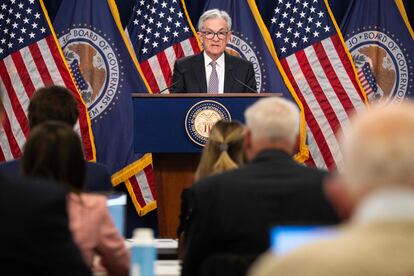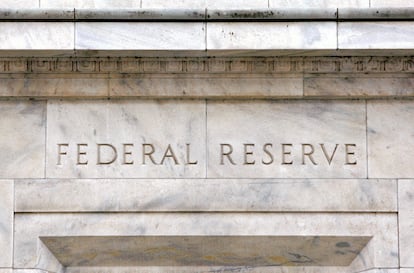The recession that never was
Despite high interest rates, a strong labor market and GDP growth give Europe and the U.S. confidence they can lower inflation while avoiding an economic downturn

The year is ending with a global economy that has provided more satisfaction than distress. Despite high interest rates, a strong labor market and GDP growth give Europe and the U.S. confidence they can bring down inflation and avoid a recession in 2024. It’s called “immaculate disinflation,” the economic buzzword introduced by the Financial Times in February 2022 to describe a scenario where inflation cools without causing a spike in unemployment.
The paradox of using economic growth to lower inflation is an act of faith, as the prevailing dogma dictates that only by raising interest rates until a recession occurs can persistent inflation be controlled. Just ask the Germans about their dreaded memories of monetary reform triggered by hyperinflation 100 years ago. However, recent economic data suggests that the United States, Spain and a few other European nations may be exceptions to the rule. Raymond Torres of the Spanish economic think tank Funcas believes that “we may be heading toward a soft landing due to excess savings and labor market resilience in the U.S. and across Europe.”
The U.S. economy grew by 5.2% in the third quarter. Despite job creation falling slightly below expectations in October (only 150,000 new jobs instead of an expected 180,000), the labor market remains robust. Inflation also dipped from 3.8% in September to 3.2% in October, while core inflation held steady at approximately 4%. The unemployment rate has remained below 4% for the past 21 months, and the average wage has increased proportionally during this period.
The situation in the European Union is quite complex as it has been experiencing a mild recession for some time already. The Eurozone economy contracted in the third quarter by 0.1% compared to the previous quarter’s growth of 0.2%. On an annual basis, the EU bloc posted a modest growth rate of 0.1%. From July to September, employment experienced a slight increase of 0.2% to 0.3%. Compared to the previous year, employment grew to 1.4%. However, progress in these areas has been hampered by the current economic struggles faced by Germany and France, which are the driving forces of this region.
Although Europe’s economy is making slow progress, international organizations and major banks estimate that GDP growth will continue next year, while inflation will continue to cool. A November report by Goldman Sachs Research indicated that, in general, “the global economy will exceed expectations in 2024, mirroring its performance in 2023.” This optimistic forecast is rooted in projections of significant income growth, coupled with declining inflation and a strong labor market. Further bolstering the global economy is the rebound in manufacturing, as well as the possibility that central banks will lower interest rates if economies show signs of slowing. All these factors are crucial elements in avoiding a recession.

The prospect of “immaculate disinflation” is further amplified by the recent shift in energy markets since the peak prices of the summer of 2022. Experts predict that lower gas prices and energy conservation initiatives across Europe will help countries surpass expectations. In this regard, Torres notes that in 2022, “the primary reason for the spike in prices was the energy crisis, but all signs now point to stabilization, which is leading to lower electricity costs.” Regarding oil markets, Torres said, “Saudi Arabia and other OPEC countries are having difficulty cutting production to levels that impact prices, which is ultimately contributing to lower inflation and higher growth.”
Despite the potential for a prosperous 2024 in both the United States and Europe, professor Manuel Alejandro Hidalgo from Pablo de Olavide University in Spain advises caution as their economic cycles are different. Moreover, there are various threats that could shake the foundations of the current growth in both regions.
Interest rates are expected to stay high in the medium and long term. This has caused long-term bond yields to rise, leading to a sharp increase in the cost of government financing. Spain, for instance, now pays 3.63% to borrow money for 10 years. Even countries that traditionally had low rates are not immune — in Germany, rates were negative and now the yield on a 10-year bond is almost 3%. In the United States, bond yields are around 5%. Conversely, if excess savings dwindle, households everywhere will feel the impact of higher interest rates and reduce their spending, putting a damper on the economy.
The European Central Bank (ECB) has urged its member countries to agree on fiscal policy changes soon. The ECB fears that the markets may punish countries like France, Spain and Italy that did not adhere to the Stability and Growth Pact (SGP), which was created to ensure economic stability within the EU.

Eurozone: gas prices
Europe is an energy-dependent continent, and Germany’s heavy reliance on Russian gas is a prime example. The country’s large industrial sector has made it more vulnerable to price hikes. Furthermore, the German economy is closely tied to China, which is also currently facing challenges. But for the Eurozone as a whole, the European Commission (EC) is predicting weak growth of only 0.6% by the end of the year, and is forecasting 1.2% growth in 2024. The EC expects inflation to rise to 3.2% next year, despite efforts to moderate it with ongoing interest rate hikes.
United States: oil and migration
Analysts say oil production and migration are two key factors that helped the U.S. economy remain resilient in recent years, and may also enable the Federal Reserve to achieve the seemingly impossible task of reducing inflation without corresponding spikes in the unemployment rate and weaker economic growth. As the world’s top oil exporter, the high oil prices of the past year have even been beneficial for the U.S. Furthermore, the labor market is highly flexible and dynamic due to high inbound migration that relieves pressure on wages. Migration has increased throughout the year, especially by working-age individuals (25-54 years), and has rebounded to pre-pandemic levels. The Federal Reserve’s report for November indicated that while the labor market remains tight, supply and demand are balancing more efficiently.
Sign up for our weekly newsletter to get more English-language news coverage from EL PAÍS USA Edition
Tu suscripción se está usando en otro dispositivo
¿Quieres añadir otro usuario a tu suscripción?
Si continúas leyendo en este dispositivo, no se podrá leer en el otro.
FlechaTu suscripción se está usando en otro dispositivo y solo puedes acceder a EL PAÍS desde un dispositivo a la vez.
Si quieres compartir tu cuenta, cambia tu suscripción a la modalidad Premium, así podrás añadir otro usuario. Cada uno accederá con su propia cuenta de email, lo que os permitirá personalizar vuestra experiencia en EL PAÍS.
¿Tienes una suscripción de empresa? Accede aquí para contratar más cuentas.
En el caso de no saber quién está usando tu cuenta, te recomendamos cambiar tu contraseña aquí.
Si decides continuar compartiendo tu cuenta, este mensaje se mostrará en tu dispositivo y en el de la otra persona que está usando tu cuenta de forma indefinida, afectando a tu experiencia de lectura. Puedes consultar aquí los términos y condiciones de la suscripción digital.
More information
Últimas noticias
Mexico seeks to shore up its defenses following US incursion in Venezuela
Hope gives way to uncertainty among Venezuelan exiles in the US after Maduro’s capture
Cubans look to Venezuela fearfully after Trump’s incursion: ‘We could be next’
The operation in Venezuela to capture Maduro threatens to widen the cracks in the MAGA movement
Most viewed
- Alain Aspect, Nobel laureate in physics: ‘Einstein was so smart that he would have had to recognize quantum entanglement’
- Gilles Lipovetsky: ‘If you want to live better and fall in love, take Prozac, don’t look to philosophy’
- Alvin Hellerstein, a 92-year-old judge appointed by Bill Clinton, to preside over Maduro’s trial in New York
- Cuba confirms death of 32 of its citizens in the US attack against Venezuela
- Why oil has been at the center of Venezuela-US conflicts for decades











































